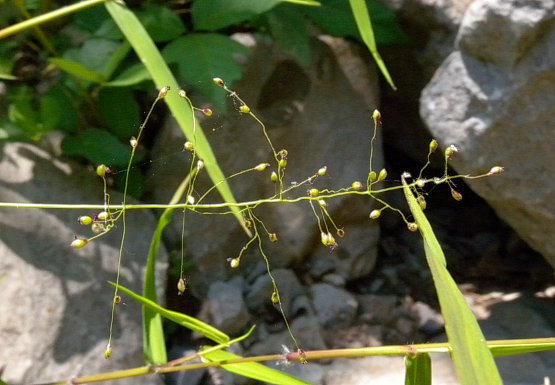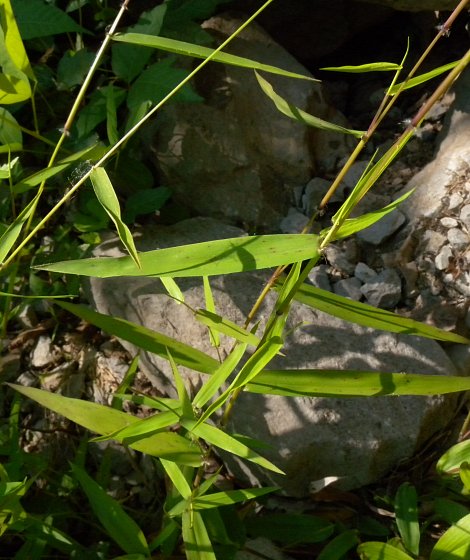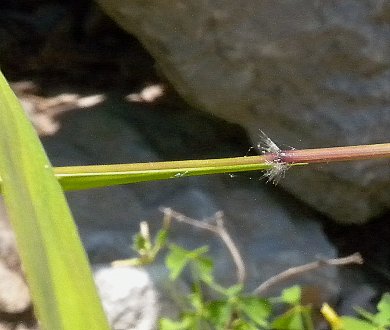
These spikelets are about 1.5 mm. long and one-half as much across; they are light green to purplish green, broadly ellipsoid in shape, longitudinally veined, and glabrous (rarely sparsely pubescent). Each spikelet consists of a short glume (about one-fourth of the length of the spikelet), a long glume, a lemma, and the floret. The long glume and lemma are the same length as the spikelet, comprising its two sides. The blooming period occurs during late spring, lasting about 1-2 weeks. Afterwards, the spikelets become light brown, producing one grain per spikelet. The grains are ellipsoid in shape, slightly flattened, and a little shorter than the spikelets. After the vernal culms wither away, they are replaced during the summer by low autumnal culms that are densely branched, forming sprawling mats. These autumn culms can produce few-flowered spikelets. The root system of this grass consists of a crown of fibrous roots.
Cultivation: This grass thrives in full sun to light shade, moist conditions, and various kinds of soil, including those that are silty, loamy, sandy, rocky, or gravelly.

Range & Habitat: The native Small-Fruited Panic Grass is occasional in southern Illinois, while in the rest of the state it is rare or absent (see Distribution Map). Illinois lies along the northwest range-limit of this grass. Habitats include moist sandy woodlands, floodplain woodlands, bottomland woodlands, woodland openings, damp meadows, sandy flatwoods, swamps, gravelly seeps and springs, and rocky banks of streams. This grass can be found in both disturbed and higher quality natural areas.
Faunal Associations: Insect feeders of this and other panic grasses (Dichanthelium spp. & Panicum spp.) include the leaf beetle Chalepus bicolor, the stilt bug Jalysus spinosus, the stink bug Mormidea lugens, some leafhoppers (Polyamia herbida, Polyamia rossi), and larvae of the following moths: Cosmopterix gemmiferella (a leaf-miner), Cycloplasis panicifoliella (a blotch leaf-miner), and Idioglossa miraculosa (a leaf skeletonizer). In addition, the caterpillars of several skippers feed on the foliage of these grasses: Hesperia sassacus (Indian Skipper), Poanes hobomok (Hobomok), Polites themistocles (Tawny-Edged Skipper), and Wallengrenia egremet (Northern Broken-Dash). The young foliage and seeds of these grasses are eaten by the Canada Goose, various ducks, wetland birds, upland gamebirds, and granivorous songbirds (especially sparrows); the Bird Table lists many of these species. Among mammals, small rodents like the House Mouse and Deer Mouse eat the seeds, while the Cottontail Rabbit and White-Tailed Deer occasionally browse on the young foliage. In addition, the young foliage is palatable to such domesticated farm animals as cattle, horses, and sheep.

Photographic Location: Along the rocky bank of a stream in an open wooded area in southern Illinois.
Comments: This grass has an unstable taxonomic history. The classification here follows Mohlenbrock (2002; 1973/2001), although other authors refer to this grass as Dichanthelium dichotomum ssp. microcarpon, Dichanthelium dichotomum var. ramulosum, or simply Dichanthelium dichotomum. In the past, Small-Fruited Panic Grass (Dichanthelium microcarpon) was assigned to the genus Panicum. In addition to these classifications, Gleason (1952) considered this grass to be a variety of Dichanthelium nitidum (Shiny Panic Grass). Small-Fruited Panic Grass can be distinguished from Forked Panic Grass (Dichanthelium dichotomum dichotomum) by its slightly smaller spikelets, wider leaves, and the long downward-pointed hairs at its nodes. Forked Panic Grass, in contrast, has either glabrous or sparsely pubescent nodes; it is usually found in drier habitats. Other similar species in this complex have velvety-hairy leaves and/or spikelets up to 2.5 mm. in length.